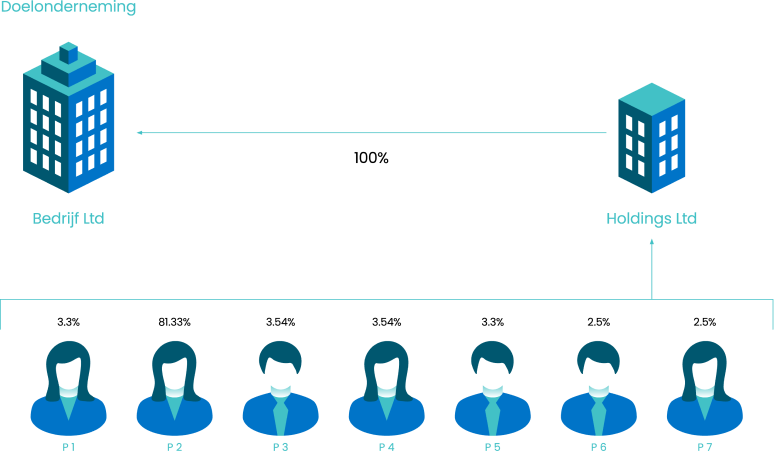Our UBO Database: Beyond the UBO
In our UBO Database, you will find owners, shareholders, and pseudo-UBOs from 0.01% ownership from millions of companies worldwide. We link these individuals to companies and business entities within complex legal business structures: this creates a deep and comprehensive picture of ownership. We call this Beyond the UBO, and it helps companies to become truly risk-aware.

Beyond the UBO
Beyond the UBO
Introduction
UBOs at Altares
Identifying UBOs worldwide
Owners
Shareholders
Pseudo-UBO’s
Our UBO database
What is a UBO at Altares?
Worldwide, we identify companies with our unique D-U-N-S-number. These companies are connected top -> bottom, creating a corporate structure. To this we connect individuals and companies that have an ownership in these companies. We identify owners, shareholders and pseudo-UBOs from 0.01% ownership and you determine the UBO based on your own guidelines.
Example of a UBO at Altares
This example shows how difficult it can be to get all the beneficiaries in the picture. Often a UBO is seen as a beneficiary with >25% shareholding. In that case, there would be three UBOs (B. Jansen, C. Jansen and P. Pieters), while there is a fourth beneficiary (A. Jansen). Many companies would determine that there are three UBOs, but so in total there are four beneficiaries that could pose a risk.
Beneficial Owner Type | Beneficial Owner Name | Degree of Seperation | Direct Ownership % | Indirect Ownership % | Beneficial Ownership % |
|---|---|---|---|---|---|
Business records | Jansen Eigendom BV | 1 | 50 | ||
Business records | Pieters Invest BV | 1 | 50 | ||
Individuals | P. Pieters | 2 | 50 | 50 | |
Business records | Jansen Invest BV | 2 | 50 | ||
Individuals | A. Jansen | 3 | 0.01 | 0.01 | |
Individuals | B. Jansen | 3 | 25 | 25 | |
Individuals | C. Jansen | 3 | 25 | 25 |
our ubo database
What makes Altares' UBO Database unique?
UBOs worldwide
Establishing UBOs worldwide
Because an organization often consists of different layers, subsidiaries, and parent companies, it is complex to find out who is actually the stakeholder(s) of the company, especially if entities are located in different countries. In order to determine the UBO, you need a database that can establish links between individuals and companies worldwide. Altares' UBO Database has global coverage.
UBOs worldwide
Relational and visual database
To make such a web of companies understandable, we visualize the connections. They are clearly outlined and at the same time you can see to what extent someone owns a certain company. With our compliance platform indueD you can map and visualize direct and indirect shareholder interest percentages with the push of a button. You can also easily filter to determine the shareholders and UBOs relevant to you.
Beyond the UBO
Just a tick-in-the-box or fully risk aware?
More and more companies have the goal of doing business consciously. They don't want to risk reputational damage and only want to do business with companies that align with their ethical values and regulations. For these companies, a UBO is more than a tick-in-the-box.
Het verschil tussen onze UBO Database en lokale UBO registers, is dat lokale registers alleen UBO’s vastleggen – geen aandeelhouders en bestuurders. Daarbij verschillen de voorwaarden van de UBO registers per land, zoals in Nederland waar een UBO een minimaal belang van 25% moet hebben. Dit maakt lokale UBO registers lastig bruikbaar voor internationale KYC-screening.
Bedrijven die zich bewust van hun risico’s willen zijn, moeten het complete plaatje weten: de complete en wereldwijde bedrijfsstructuur met daarin de aandeelhouders, bestuurders en eigenaren vanaf 0,01% eigenaarschap.
The complete compliance picture
With our UBO Database, you can determine UBOs worldwide from 0.01% ownership and be truly risk aware.
More and more companies have the goal of doing business consciously. They don't want to risk reputational damage and only want to do business with companies that align with their ethical values and regulations. For these companies, a UBO is more than a tick-in-the-box.
The difference between our UBO Database and local UBO registries, is that local registries only record UBOs - not shareholders and pseudo-UBOs. Also, the conditions of UBO registries differ by country, in the Netherlands for example, where a UBO needs to have at least 25% stake. This makes local UBO registries difficult to use for international due diligence management.
Companies that want to be aware of their risks need to know the complete picture: the complete and global corporate structure that includes the owners, shareholders and pseudo-UBOs from 0.01% ownership.
How it works
Getting the right information
Our UBO Database answers the most important questions in the due diligence process.
Are they?
- Financial solvent?
- Regulated?
- On a stock exchange?
- On a watch list?
- Potential PEPS'?
- Unfavorable in the media?
- Sanctions lists?
- Terrorists?
Where is?
- Are they based?
- Their registered office?
- Their trading address?
- Their span of control?
- Their geographical footprint?
What is?
- Legal name?
- The main activity?
- The legal entity?
- The type of biz transaction?
- The risk category?
Who are?
- The owners?
- The directors?
- The shareholders?
- The UBO's?
- Related companies?
Compliance & groei
Thoroughly screen your relationships, but in a customer-friendly way
Do you want to protect your organization optimally, but at the same time contribute to growth? You can use our UBO Database 'under water' during your due diligence process. When a new client applies, for example through your website, we screen this company unnoticed while you welcome your new client with open arms. You can automate the outcome of the screening in your own systems and applications, such as whether or not to accept the client.
Speed up your due diligence process
You can automate the outcome of the screening into your own systems and applications, speeding up your due diligence process by up to 80%.
More information?
We are happy to introduce you to our UBO Database and the possibilities for your organization.
UBO Structures
Direct vs. indirect
shareholding
Determining UBO is relatively straightforward for a publicly listed company with direct shareholders. However, it becomes trickier when shareholding is disguised by multiple layers of indirect ownership. These ownership structures pose hefty risks and therefore require greater diligence on the part of compliance teams to demonstrate that they have taken all possible steps to identify UBO.




Direct and indirect ownership: putting the puzzle pieces together
In this example, person P1 is a direct owner of company C1 and owns 30% of the shares. Person P2 is an indirect owner of company C1 and owns 70% of the shares.

Simple indirect shareholdings
This diagram visualizes a typical scenario that illustrates how organizations determine the UBO of a target company. In this situation, the shares are owned by multiple individuals. In this example, Person 2 owns 81.33% of the shares of A Holdings Ltd. The level and lower limit of ownership that an organization wants to work with depends, in part, on its risk appetite. Thorough identification of UBOs requires reliable information and, to the extent necessary, detailed research.

Different levels of indirect shareholding
In this scenario, there are multiple levels of indirect ownership. In this case, Mr. Vos has a 32% interest in target company A. (50% x 65% = 32%), Mr. de Wit has 14% and Mr. Maas has 50%. Note: Mr. de Wit has both a direct and an indirect interest in company B.

Circular relationships (indirect shareholding at multiple levels)
Within this construct, organizations create a loop in which they own interests in other companies in the same loop as well as possibly shares in themselves. By adding up the ownership percentage of each company, for many organizations in the loop 100% of their ownership will be traceable to other companies in the loop. If not, then the deficit represents the percentage owned by individuals according to the shareholder register. These stated percentages will be lower than what the individuals actually own and manage when they are the only individuals involved in the loop.

Our products
How can you use our UBO Database?
From user-friendly tools to integration into your own systems and applications.
indueD
The complete compliance platform for due diligence management. Screen customers and suppliers in one convenient environment.
API
Integrate the UBO Database within your own systems, such as CRM and ERP, for automated screening within your existing workflow.
Vergelijking
Waarin verschilt onze UBO Database met die van andere aanbieders?
Altares is de enige aanbieder met één database voor wereldwijde UBO identificatie.
Features | Altares | BvD | Graydon | KvK |
|---|---|---|---|---|
Nationaal | ||||
Internationaal | ||||
Aandeelhouders vanaf 0,01% | ||||
Bestuurders | ||||
UBO’s > 25% | ||||
UBO’s | Sometimes | |||
Aandeelhoudersstructuur visualisatie | ||||
Alert wanneer UBO veranderd | ||||
Grootste zakelijke database | ||||
Wereldwijde unieke identifier (DUNS) | ||||
Wereldwijde handelsbetalingen | ||||
API |
FAQ
I want to automate my customer acceptance process
For a clean, efficient and effective customer underwriting process, you need a reliable source of up-to-date business information. Integrate Dun & Bradstreet data directly into your own environment and automate your underwriting process for fast, informed and consistent decisions. Read more.
I want to assess the risks with prospects
Did a promising lead come in? Good for you! But now it's time to make some business decisions. Are you going to accept him as a customer? Can he buy on credit, and if so on what terms? When making these decisions, use our reliable business information, such as our credit risk data. Then you avoid doing business with companies that actually cannot meet their financial obligations. Read more.
I want to understand the risks of a country's business environment
Altares Dun & Bradstreet's country information informs you of everything you need to know about doing business in a specific country. You will be kept informed of important changes and of expected national developments within a country that may affect your business. Read more.
I want to monitor the developments within my debtor portfolio
By enriching your own client information with valuable Altares Dun & Bradstreet data, you create a clear overview and always know exactly how your client portfolio is doing. Where are your risks and where are your opportunities? Based on this insight you can segment your dunning process and determine focus within your portfolio. Read more.